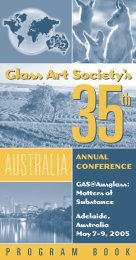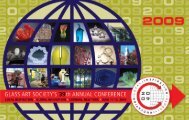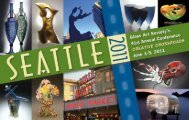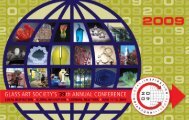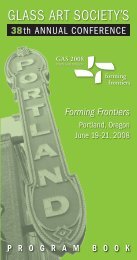GASNews October/ November 2011 Volume 22 ... - Glass Art Society
GASNews October/ November 2011 Volume 22 ... - Glass Art Society
GASNews October/ November 2011 Volume 22 ... - Glass Art Society
You also want an ePaper? Increase the reach of your titles
YUMPU automatically turns print PDFs into web optimized ePapers that Google loves.
Tech Issues<br />
Mobile <strong>Glass</strong> Studios<br />
By Eddie Bernard<br />
The history of mobile glass studios dates<br />
back to the beginning of the Studio <strong>Glass</strong><br />
Movement. Listening to Fritz Dreisbach<br />
or Marvin Lipofsky talk about the early<br />
days, it seems there has always been<br />
a high level of excitement among glass<br />
craftspeople to share the experience.<br />
Of course, it doesn’t hurt that a demonstration<br />
is traditionally followed by a<br />
healthy round of applause.<br />
Location, location, location — the old<br />
real-estate joke’s punch line holds true<br />
for glass too. Renaissance fairs, music<br />
festivals, parties, parks and schools<br />
are venues where artists can use their<br />
exhibitionist traits to earn a fee, to sell<br />
work, and to educate. Let’s not forget that<br />
the terms “vagabond” and “glass artist”<br />
share etymological roots.<br />
Some of the earliest mobile studios<br />
were built on existing trailers. Often the<br />
units had only one axle, but, as seen<br />
in the 1582 Turkish painting Parade of<br />
the Guild of the <strong>Glass</strong>blowers, at least<br />
one early unit was built on six axles (one<br />
per wheel). Bill Boysen, who started the<br />
graduate glass program at Southern<br />
Illinois University Carbondale (SIUC) in<br />
1966, is often credited with building<br />
the first mobile glassblowing studio in<br />
the US. Completed in 1970, Boysen’s<br />
Aunt Gladys (named to acknowledge the<br />
need for a rich aunt in order to work with<br />
glass) was funded by a research grant to<br />
help him expose more people to artistic<br />
glassblowing. Aunt Gladys is in its second<br />
incarnation now, having been completely<br />
built anew by Boysen soon after Ché<br />
Rhodes became head of the SIUC glass<br />
program. The small, enclosed, double-axle<br />
trailer houses a 60-lb furnace, a glory hole<br />
and two annealing ovens. It is powered<br />
by electricity and propane. Those of you<br />
who have attended a handful of GAS<br />
conferences will agree Aunt Gladys has<br />
been a staple venue, traditionally hosting<br />
14<br />
student demonstrations. Rumor (a rumor<br />
I hereby set in motion) has it that Aunt<br />
Gladys has been nominated for GAS’ two<br />
most prestigious awards, the Lifetime<br />
Achievement Award and the Honorary<br />
Lifetime Membership Award.<br />
Marvin Lipofsky provided me with<br />
several examples of mobile studios from<br />
the 1970s, including Brian Lonsway’s<br />
1972 Toledo, OH, trailer with rims that<br />
matched his 1932 Chevy. Steve Beasely<br />
built his furnace inside a covered trailer<br />
and dragged it around the Seattle area<br />
in the early ’70s. Bill Brunner’s Duo Glide<br />
mobile shop was used in 1976 at The<br />
Great California <strong>Glass</strong> Symposium, which<br />
was held in conjunction with the American<br />
Craft Council show at the Fort Mason<br />
Center in San Francisco. Demonstrators at<br />
that symposium included Ann Morhauser,<br />
Bill Brunner and Marvin Lipofsky.<br />
Studio Inferno’s Mitchell Gaudet and<br />
Scott and Bruce Benefield built Hell on<br />
Wheels in 1996 with the help of Althea<br />
Holden and Don Nisonger. Starting with<br />
a Nuway NW13182 single-axle trailer for<br />
a 6’ x 4’ foundation, they added a 3/4”<br />
plywood deck, a 50-lb invested pot beehive<br />
furnace and a 12-inch fiber-lined glory<br />
hole. The trailer was rated to transport<br />
up to 2,000 lbs, and the total cost in<br />
1996 was approximately $2,000. Hell on<br />
Wheels was built and paid for by Studio<br />
Inferno, but it did receive some funding<br />
Turkish mobile unit,<br />
circa 1568, from<br />
Parade of the Guild<br />
of the <strong>Glass</strong>blowers,<br />
(detail), 1582.<br />
(Photo courtesy of<br />
Marvin Lipofsky)<br />
from the New Orleans <strong>Art</strong> Council for<br />
several years to travel to schools and<br />
do demonstrations. Demos were always<br />
free of charge. Gaudet explains, “We<br />
reached out to all as a teaching and<br />
demonstrating unit. Most schools had<br />
limited arts programming, so for us to<br />
bring fire and glass to them was a real<br />
treat.” Hell on Wheels was typically pulled<br />
into the stationary studio and fired up<br />
on natural gas to operating temperature,<br />
then hauled to the demonstration site,<br />
where propane was used to fire the venturi<br />
mixer. A small kiln (about the size of a<br />
color oven) ran off a 120V extension cord<br />
and was used for annealing. “Our biggest<br />
impact was demoing at the New Orleans<br />
Jazz and Heritage Festival. It never ceased<br />
to amaze me how many people would<br />
watch our demos in the heat and in lieu<br />
of all the great music there…” Gaudet<br />
recalls. Scott Benefield adds, “That’s<br />
where we discovered its real function – an<br />
advertising tool to promote retail sales<br />
at a craft event. That became its sole<br />
function ever afterward, as we found it<br />
roughly doubled our sales.” The unit was<br />
eventually destroyed by a construction<br />
company where it was stored.<br />
Scott Benefield had a second go at<br />
mobile-studio design when he built a<br />
100-lb freestanding pot furnace in the<br />
back of a horse trailer. For electricity and<br />
fuel, it used two big propane tanks on



